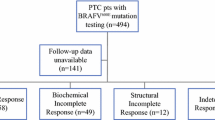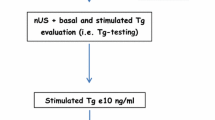Abstract
Purpose
As the most frequent and specific genetic alteration in papillary thyroid carcinoma (PTC), BRAFV600E has an intimate relationship with more invasive tumour and higher postoperative recurrence risk in PTC patients. We investigate the effect of radioactive iodine (RAI) therapy on the clinical outcome in PTC patients with the BRAFV600E mutation without distant metastases.
Methods
This retrospective study included PTC 228 patients without distant metastases who underwent total or near-total thyroidectomy and RAI treatment in our hospital from January 2011 to July 2014. The BRAFV600E status of the primary lesions was determined and the patients were divided into two groups according to the presence of the mutation. Serological and imaging data were collected at a median follow-up of 2.34 years after RAI administration. Suppressed and stimulated thyroglobulin (Tg), Tg antibody, diagnostic whole-body scintigraphy, and other imaging examinations were used to assess clinical outcome, which was defined as excellent response, indeterminate response, biochemical incomplete response and structural incomplete response.
Results
The BRAFV600E mutation was observed in 153 of the 228 patients (67.1 %). The clinicopathological features did not differ between the BRAFV600E mutatation and wild-type groups except age at diagnosis (P = 0.000), tumour size (P = 0.023) and TNM stage (P = 0.003). Older age and more advanced TNM stage were prevalent in the BRAFV600E mutatation group, whereas tumours were slightly larger in the BRAFV600E wild-type group. The response to RAI therapy was evaluated in both the entire series and the patients with a high recurrence risk, and no significant difference in response was found between the BRAFV600E mutatation and the wild-type groups (P = 0.881 and P = 0.851, respectively).
Conclusion
The clinical response to timely postsurgical RAI therapy is not inferior in BRAFV600E mutation PTC patients without distant metastases, which suggests that RAI therapy might improve the general clinical outcome in this patient group.
Similar content being viewed by others
References
Leenhardt L, Grosclaude P, Cherie-Challine L. Increased incidence of thyroid carcinoma in France: a true epidemic or thyroid nodule management effects? Report from the French Thyroid Cancer Committee. Thyroid. 2004;14:1056–60.
Pacini F, Castagna MG. Approach to and treatment of differentiated thyroid carcinoma. Med Clin N Am. 2012;96(2):369–83.
Enewold L, Zhu K, Ron E, Marrogi AJ, Stojadinovic A, Peoples GE, et al. Rising thyroid cancer incidence in the United States by demographic and tumor characteristics, 1980-2005. Cancer Epidemiol Biomarkers Prev. 2009;18:784–91.
Jonklaas J, Sarlis NJ, Litofsky D, Ain KB, Bigos ST, Brierley JD, et al. Outcomes of patients with differentiated thyroid carcinoma following initial therapy. Thyroid. 2009;16:1229–42.
Lango M, Flieder D, Arrangoiz R, Veloski C, Yu JQ, Li T, et al. Extranodal extension of metastatic papillary thyroid carcinoma: correlation with biochemical endpoints, nodal persistence, and systemic disease progression. Thyroid. 2013;23:1099–105.
Falvo L, Catania A, D'Andrea V, Marzullo A, Giustiniani MC, De Antoni E. Prognostic importance of histologic vascular invasion in papillary thyroid carcinoma. Ann Surg. 2005;241:640–6.
Ito Y, Tomoda C, Uruno T, Takamura Y, Miya A, Kobayashi K, et al. Prognostic significance of extrathyroid extension of papillary thyroid carcinoma: massive but not minimal extension affects the relapse-free survival. World J Surg. 2006;30:780–6.
Mazzaferri EL. Management of low-risk differentiated thyroid cancer. Endocr Pract. 2007;13:498–512.
Jukkola A, Bloigu R, Ebeling T. Prognostic factors in differentiated thyroid carcinomas and their implications for current staging classifications. Endocr Relat Cancer. 2004;11:571–9.
Radowsky JS, Howard RS, Burch HB. Impact of degree of extrathyroidal extension of disease on papillary thyroid cancer outcome. Thyroid. 2014;24:241–4.
Davies H, Bignell GR, Cox C, Stephens P, Edkins S, Clegg S, et al. Mutations of the BRAF gene in human cancer. Nature. 2002;417:949–54.
Nikiforova MN, Nikiforov YE. Molecular genetics of thyroid cancer: implications for diagnosis, treatment and prognosis. Expert Rev Mol Diagn. 2008;8:83–95.
Liu X, Yan K, Lin X, Zhao L, An W, Wang C, et al. The association between BRAFV600E mutation and pathological features in PTC. Eur Arch Otorhinolaryngol. 2014;271:3041–52.
Xing M, Alzahrani AS, Carson KA, Shong YK, Kim TY, Viola D, et al. Association between BRAF V600E mutation and recurrence of papillary thyroid cancer. J Clin Oncol. 2015;33(1):42–50.
Lisa MC, John EP, Manisha HS. Role of BRAF in thyroid oncogenesis. Clin Cancer Res. 2011;17(24):7511–7.
Yang K, Wang H, Liang Z, Liang J, Li F, Lin Y. BRAFV600E mutation associated with non-radioiodine-avid status in distant metastatic papillary thyroid carcinoma. Clin Nucl Med. 2014;39(8):675–9.
Ito Y, Yoshida H, Kihara M, Kobayashi K, Miya A, Miyauchi A. BRAF(V600E) mutation analysis in papillary thyroid carcinoma: is it useful for all patients? World J Surg. 2014;38:679–87.
Haugen BR, Alexander EK, Bible KC, Doherty G, Mandel SJ, Nikiforov YE, et al. 2015 American Thyroid Association management guidelines for adult patients with thyroid nodules and differentiated thyroid cancer. Thyroid. 2015. doi:10.1089/thy.2015.0020.
Vaisman F, Shaha A, Fish S, Tuttle RM. Initial therapy with either thyroid lobectomy or total thyroidectomy without radioactive iodine remnant ablation is associated with very low rates of structural disease recurrence in properly selected patients with differentiated thyroid cancer. Clin Endocrinol (Oxf). 2011;75:112–9.
Tuttle RM, Tala H, Shah J, Leboeuf R, Ghossein R, Gonen M, et al. Estimating risk of recurrence in differentiated thyroid cancer after total thyroidectomy and radioactive iodine remnant ablation: using response to therapy variables to modify the initial risk estimates predicted by the new American Thyroid Association staging system. Thyroid. 2010;20:1341–9.
Podnos YD, Smith DD, Wagman LD, Ellenhorn JD. Survival in patients with papillary thyroid cancer is not affected by the use of radioactive isotope. J Surg Oncol. 2007;96(1):3–7.
SEER Stat Fact Sheets: Thyroid Cancer. Bethesda, MD: National Cancer Institute. http://seer.cancer.gov/statfacts/html/thyro.html.
American Thyroid Association (ATA) Guidelines Taskforce on Thyroid Nodules and Differentiated Thyroid Cancer; Cooper DS, Doherty GM, Haugen BR, Kloos RT, Lee SL, Mandel SJ, et al. Revised American Thyroid Association management guidelines for patients with thyroid nodules and differentiated thyroid cancer. Thyroid. 2009;19:1167–214.
Mazzaferri EL, Massoll N. Management of papillary and follicular (differentiated) thyroid cancer: new paradigms using recombinant human thyrotropin. Endocr Relat Cancer. 2002;9(4):227–47.
Randolph GW, Duh QY, Heller KS, LiVolsi VA, Mandel SJ, Steward DL, et al. The prognostic significance of nodal metastases from papillary thyroid carcinoma can be stratified based on the size and number of metastatic lymph nodes, as well as the presence of extranodal extension. Thyroid. 2012;22:1144–52.
Giovanella L, Ceriani L, Ghelfo A, Keller F. Thyroglobulin assay 4 weeks after thyroidectomy predicts outcome in low-risk papillary thyroid carcinoma. Clin Chem Lab Med. 2005;43:843–7.
Piccardo A, Arecco F, Puntoni M, Foppiani L, Cabria M, Corvisieri S, et al. Focus on high-risk DTC patients: high postoperative serum thyroglobulin level is a strong predictor of disease persistence and is associated to progression-free survival and overall survival. Clin Nucl Med. 2013;38:18–24.
Xing M, Westra WH, Tufano RP, Cohen Y, Rosenbaum E, Rhoden KJ, et al. BRAF mutation predicts a poorer clinical prognosis for papillary thyroid cancer. J Clin Endocrinol Metab. 2005;90:6373–9.
Elisei R, Viola D, Torregrossa L, Giannini R, Romei C, Ugolini C, et al. The BRAF(V600E) mutation is an independent, poor prognostic factor for the outcome of patients with low-risk intrathyroid papillary thyroid carcinoma: single-institution results from a large cohort study. J Clin Endocrinol Metab. 2012;97:4390–8.
Tufano RP, Teixeira GV, Bishop J, Carson KA, Xing M. BRAF mutation in papillary thyroid cancer and its value in tailoring initial treatment: a systematic review and meta-analysis. Medicine (Baltimore). 2012;91:274–86.
Prescott JD, Sadow PM, Hodin RA, Le LP, Gaz RD, Randolph GW, et al. BRAFV600E status adds incremental value to current risk classification systems in predicting papillary thyroid carcinoma recurrence. Surgery. 2012;152:984–90.
Zheng XQ, Wang C, Xu M, Yu Y, Yun XW, Jia YS, et al. Progression of solitary and multifocal papillary thyroid carcinoma a retrospective study of 368 patients. Chin Med J (Engl). 2012;125(24):4434–9.
Benbassat CA, Mechlis FS, Hirsch D. Clinicopathological characteristics and long-term outcome in patients with distant metastases from differentiated thyroid cancer. World J Surg. 2006;30(6):1088–95.
Bartenstein P, Calabuig EC, Maini CL, Mazzarotto R, Muros de Fuentes MA, Petrich T, et al. High-risk patients with differentiated thyroid cancer T4 primary tumors achieve remnant ablation equally well using rhTSH or thyroid hormone withdrawal. Thyroid. 2014;24(3):480–7.
Kammori M, Fukumori T, Sugishita Y, Hoshi M, Shimizu K, Yamada T. Radioactive iodine (RAI) therapy for distantly metastatic differentiated thyroid cancer (DTC) in juvenile versus adult patients. Endocr J. 2015;62(12):1067–75.
Author information
Authors and Affiliations
Corresponding author
Ethics declarations
Funding
This study was funded by National Natural Science Foundation of China (81571714).
Conflicts of interest
None.
Ethical approval
This article does not describe any studies with human participants performed by any of the authors. For this type of study formal approval is not required.
Informed consent
Informed consent was obtained from all individual participants included in the study.
Additional information
Jiao Li and Jun Liang contributed equally to this work as first authors.
Rights and permissions
About this article
Cite this article
Li, J., Liang, J., Zhao, T. et al. Noninferior response in BRAFV600E mutant nonmetastatic papillary thyroid carcinoma to radioiodine therapy. Eur J Nucl Med Mol Imaging 43, 1034–1039 (2016). https://doi.org/10.1007/s00259-015-3305-1
Received:
Accepted:
Published:
Issue Date:
DOI: https://doi.org/10.1007/s00259-015-3305-1




